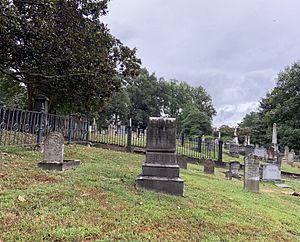Anna Whitehead Bodeker facts for kids
Quick facts for kids
Anna Whitehead Bodeker
|
|
|---|---|
| Born | July 27, 1826 Midland Park, New Jersey, U.S.
|
| Died | October 26, 1904 (aged 78) Richmond, Virginia, U.S.
|
| Nationality | American |
| Occupation | Women's rights activist, suffragist |
| Spouse(s) | Augustus Bodeker |
| Children | 3 (one died in infancy) |
| Parent(s) | Jesse and Sophia Whitehead |
Anna Whitehead Bodeker (July 27, 1826 – October 26, 1904) was an American suffragist. A suffragist is someone who works to get women the right to vote. Anna led the first efforts to organize for women's voting rights in Virginia. She invited national leaders to speak in Richmond, Virginia. She also wrote newspaper articles to gain support. In 1870, she helped start the Virginia State Woman Suffrage Association. This was the first group in Virginia focused on women's right to vote.
Contents
Anna Bodeker's Early Life
Anna Whitehead was born on July 27, 1826. Her birthplace was Midland Park, New Jersey. Her parents, Jesse and Sophia Whitehead, were immigrants from England. When Anna was 10, her family moved to Richmond, Virginia. Her father helped build and manage a cotton mill there.
Anna married Augustus Bodeker on January 15, 1846. She was 18 years old. Her husband was from Germany. He worked as a clerk before opening his own pharmacy in 1864. Anna and Augustus had three daughters. Sadly, their first daughter died when she was a baby. The Bodeker family lived in the Church Hill area of Richmond. They bought their home in 1862.
Fighting for Women's Right to Vote
Anna Bodeker became very interested in the National Woman Suffrage Association (NWSA) in the 1860s. This group worked for women's voting rights across the country.
Starting the Movement in Virginia
On January 26, 1870, Anna invited a NWSA leader, Paulina Kellogg Wright Davis, to her home. Ms. Davis spoke to local leaders and Anna's friends. After this meeting, Anna was ready to start a women's suffrage group in Richmond. Paulina Davis later wrote that Anna was brilliant. She believed Anna could lead the women's suffrage movement in the Southern states.
In March 1870, a Richmond newspaper published an article. Anna Bodeker and other women wrote it. It was called "Defence of Woman Suffrage." The article explained that giving women the right to vote would help them get better jobs. It would also help them become more independent.
The Virginia State Woman Suffrage Association
Anna Bodeker invited another NWSA organizer, Matilda Joslyn Gage, to Richmond. Ms. Gage spoke at a public meeting on May 5, 1870. The next evening, the Virginia State Woman Suffrage Association (VSWSA) was founded. This was the first women's suffrage group in Virginia. Anna Bodeker was chosen as its president.
Other important people helped start the group. They included John C. Underwood, a judge, and his wife Maria. Ralza M. Manly, a superintendent from the Freedmen's Bureau, also joined. Martha Haines Butt, a novelist, and Andrew Washburne, who led Richmond's public schools, were also founders. Elizabeth Van Lew, a former Union spy, was a key member too.
The VSWSA soon joined with the national NWSA. They sent a delegate to represent Virginia at the national meeting.
Working with National Leaders
Anna Bodeker and the VSWSA brought famous suffragists to Richmond. These included Susan B. Anthony, Lillie Devereux Blake, and Isabella Beecher Hooker. They came to speak about women's right to vote. Even with these well-known speakers, not enough people came to create lasting support.
In May 1871, Susan B. Anthony asked Anna Bodeker to join a special committee. This committee encouraged NWSA members to vote in local elections. They said the 14th and 15th Amendments to the U.S. Constitution gave women this right.
Anna Bodeker tried to vote in Richmond on November 7, 1871. Election officials would not let her cast her ballot. So, Anna asked them to put a note in the ballot box instead. Her note said she had the right to vote under the U.S. Constitution. The Richmond Times-Dispatch newspaper reported on her attempt to vote.
A Setback in the Legislature
In 1872, Anna Bodeker asked the Virginia General Assembly for a law. She wanted women to have the right to vote. She argued that the 14th and 15th Amendments supported this right. Anna asked the lawmakers to pass laws to allow voting "without regard to sex." She also asked to speak to the assembly herself.
Her request was sent to a committee, but the lawmakers did not act on it.
Challenges and Stepping Back
Even with Anna's strong organizing skills, the women's suffrage movement struggled in Virginia. Many people expected women to stick to traditional roles. Early suffragists were sometimes seen as too radical. Also, the VSWSA was linked to groups that were not popular with some white residents in Richmond. This made it hard to get widespread support.
Anna Bodeker stopped her public work for women's suffrage after 1872. The Virginia State Woman Suffrage Association also became less active soon after.
Later Life and Legacy
In her later years, Anna Bodeker faced health challenges. In 1873, her family sought care for her well-being. She returned to Richmond in 1874.
Anna's husband passed away on July 26, 1884. Anna lived in the family home with her two daughters, Pearl and Ruby. She died on October 26, 1904. She was buried in Hollywood Cemetery.
Anna Bodeker was honored by the Library of Virginia in 2003. She was part of their "Virginia Women in History" group. Her name is also on the Wall of Honor at the Virginia Women's Monument. This monument is in Capitol Square in Richmond.



